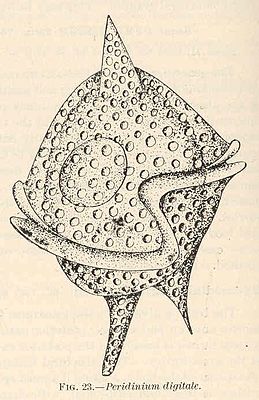Peridinium
| Peridinium | ||||||||||||
|---|---|---|---|---|---|---|---|---|---|---|---|---|

Peridinium digital |
||||||||||||
| Systematics | ||||||||||||
|
||||||||||||
| Scientific name | ||||||||||||
| Peridinium | ||||||||||||
| Ehrenberg , 1832 |
Peridinium is a genus of dinoflagellates with around 40 species that occur mainly in freshwater , but also in seawater .
features
The representatives are unicellular. They have a longitudinal furrow (sulcus) and a belt-like pronounced transverse furrow (cingulum). A scourge arises in the longitudinal furrow, it is long and extends beyond the end of the cell. The second flagella lies in the transverse furrow and allows the unicellular organism to rotate around its longitudinal axis and feed it. The transverse furrow divides the cell into two equally sized halves. Beneath the cell surface are richly ornamented cellulose sheets. The cell is almost spherical in outline. Inside the cell there is a large nucleus and a number of small and mostly brown plastids . The plastids can also be colorless depending on the species. Some species have an eye spot in the back of the cell .
The cells are 18 to 100 micrometers long. The species differ in the cell size, the size ratio of the two cell halves, the length of the longitudinal furrow, the shape and flattening of the cells, the ornaments and the arrangement of the cellulose plates and the presence and color of the plastids.
Asexual reproduction occurs through division into two parts, through the formation of zoospores or through the formation of daughter cells without furrows and flagella. Sexual reproduction takes place through the fusion of two genetically different but morphologically identical sex cells ( isogamy ). The permanent zygote thus formed germinates later with reduction division .
Occurrence
Peridinium occurs in all waters. They feed photoautotrophically , but they can also feed themselves by absorbing dissolved organic substances ( mixotrophy ). Often there are mass occurrences in spring.
supporting documents
- Karl-Heinz Linne von Berg, Michael Melkonian u. a .: The Kosmos algae guide. The most important freshwater algae under the microscope. Kosmos, Stuttgart 2004, ISBN 3-440-09719-6 , p. 94.